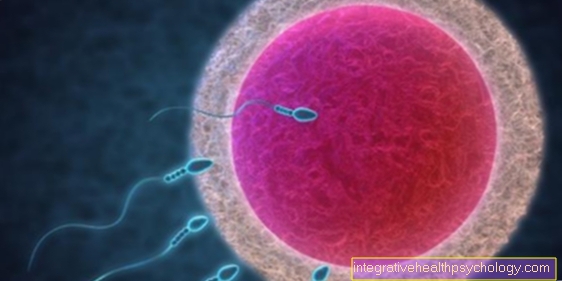conception
The causes of a difficult conception
After a certain point in time, almost every woman feels the desire to have a child, but not in all cases this works right away. Getting pregnant can take a long time and put an enormous strain on women who want to have children. In some cases, the failure to conceive is due to low hormone levels, poor lifestyle, or easy-to-solve problems.
The question of whether the reason for the childlessness lies with the man or the woman cannot be answered as a tendency, because in 50% of the cases the failure to conceive is in the man and in 50% of the cases in the woman. The main problem with men is temporary or permanent infertility due to a lack of sperm production. In women, the underlying problem is often due to hormone levels.

The earlier you go to a specialist if you don't want to have children, the faster you can find a remedy. As an affected woman, you can usually judge for yourself whether there is a hormonal disorder, because the signs are quite clear. An irregular cycle with fluctuating menstrual bleeding is the first indication in most cases. If there is such a hormonal disorder, in most cases it is due to a too low progesterone level.
If the female body lacks progesterone (the so-called luteal hormone), a fertilized egg cell is not able to implant itself in the uterus - it is then rejected like an unfertilized egg cell. The progesterone deficiency is usually due to a disturbed follicle maturation and can be remedied by medication that stimulates the maturation of the egg cells (e.g. clomiphene). Another option is the direct administration of progesterone.
Furthermore, an increased prolactin level can be to blame if it is a long time to get pregnant. A symptom of too much prolactin is an irregular cycle with a partial absence of menstruation. In the course of pregnancy, prolactin is responsible for the development of the mammary glands and the shooting in of breast milk. If the female body is oversupplied with prolactin, the production of other hormones is reduced. These hormones include the follicle-stimulating hormone FSH and the ovulation-triggering (luteinizing) hormone LH, both of which are essential for the successful "initiation" of pregnancy.
In some cases, however, the reason for not conceiving is also due to a disease called polycystic ovarian syndrome (PCO for short). In this disease, follicles grow in the ovary, but these follicles do not fully mature and wither away. In clinical studies it has been found that polycystic ovary syndrome is often associated with insulin resistance. This means that overweight women particularly suffer from this disease.
If there is a desire to have children and the conception is difficult, a specialist can help the affected couple quickly and specifically. This help should therefore be used as soon as possible.
How do I get pregnant? Learn more about this topic.
The natural planning
Natural family planning is about methods that increase the chance of conception without the use of chemical or hormonal agents.
Basically, conception is most likely a short time before or after ovulation. Knowing when a woman will ovulate will help increase the chances of conceiving. This is because sperm can survive in the woman's body for about three to five days and a mature egg cell is capable of fertilization about twelve to twenty-four hours after ovulation.
The fertile days can be easily determined with the help of the temperature method. It is important to measure and write down the woman's temperature every morning (if possible, always at the same time). Shortly after the monthly ovulation, the temperature rises for a few days and after several months the day of ovulation can be precisely determined using a temperature curve. The quality of the discharge can also help in planning a child and, with daily assessment, increase the chances of getting pregnant. A few days before and after ovulation, the discharge (cervical mucus) is thin, light and strings.
The cervix also offers an opportunity to understand the female cycle, because it can be easily felt with one or two fingers. The opening of the cervix is usually very narrow and tight, but the degree of opening can vary considerably over the course of the female cycle. A short time after the menstrual period, the external cervix is narrow and also feels very hard. At about the same time as ovulation, it becomes softer and begins to open, so the woman's body is in the fertile phase at this point and the probability of conception is particularly high.
You might also be interested in these articles:
- Ovulation and temperature
- How does the discharge change during ovulation?
How can you promote conception?
There are numerous ways and behaviors that can be used to aid conception. It is important that both partners maintain a healthy lifestyle, which includes a varied and nutritious diet, physical exercise and adequate sleep. A weight normalization should be aimed for in the case of severe underweight or overweight and can have a fertile effect.
Women should regularly take folic acid in the form of dietary supplements if they want to have children. In addition, the complete renunciation of tobacco and drugs as well as excessive alcohol consumption can have a positive effect on conception. It is also important to approach family planning in an environment that is as stress-free as possible. In particular, this also applies to the self-constructed stress that many couples experience when pregnancy does not occur immediately as desired.
The chance of conception increases if you have sexual intercourse on the days around ovulation. To increase the chances of conception, it is often recommended that you sleep together about every two to three days. Certain positions during sex, in which the penis penetrates particularly deeply into the vagina, as well as elevating the pelvis after orgasm, can also promote conception. The attempt is made to make it easier for the sperm to ascend to the egg cell. Not using lubricant gel can also be beneficial, as the sperm quality is negatively affected by many products.
Find out more about the topic here: Diet during pregnancy.
Which tea promotes conception?
There are several types of tea that are said to have a cycle-regulating effect and a fertility-promoting effect. These include tea blends made from lady's mantle, monk's pepper or raspberry leaves. In addition, verbena and mugwort are said to promote conception. Popular and frequently used culinary herbs such as basil or rosemary can also have a positive effect on their own or in the form of tea.
It is advisable to speak to a gynecologist or pharmacist beforehand about the safety of special tea blends. It is also advisable to ensure that the product comes from a good source when shopping, so as not to ingest harmful substances through a cheap and possibly poor quality tea.
Here you will find Tips to get pregnant.
How can you calculate the day of conception?
The day of conception can only be calculated retrospectively, i.e. retrospectively. Since it is only clear after pregnancy has occurred that conception and thus fertilization must have taken place, this kind of arithmetic approach is necessary. If, on the other hand, the term “day of conception” in the context of family planning means the determination of the optimal time window for conception, it is a prospective calculation. However, since this fertile time window does not always go hand in hand with fertilization, or conception, the term "day of conception calculation" should be dispensed with in order to better distinguish this type of calculation and instead the determination of the fertile days or ovulation should be used.
There are numerous online calculators for both pro and retrospective calculations, which can be used to conveniently enter either the first day of the last bleeding including the length of the cycle or the planned due date. It is important to emphasize, however, that both the aforementioned online calculator and the determination of the day of receipt presented below can never pinpoint the actual or planned conception to an exact day, but rather a period of several days is always determined.
If pregnancy has occurred, the planned date of birth is used as a basis. However, this type of calculation is also possible if the child has already been born, in which case the starting date of the invoice is the birthday. Then 267 days are subtracted, which is the average length of pregnancy. However, a few days more or less must be deducted if it is a transfer or a premature birth.
Another form of calculation is used in the prospective calculation. To illustrate and simplify the following calculation of ovulation and thus a potentially subsequent conception, a 28-day cycle is assumed. Ovulation takes place about halfway through the cycle, around the 14th day. Since sperm have a maximum lifespan of around five days, the time window expands accordingly to five days before ovulation, which explains the beginning of the fertile days from the ninth day of the cycle. In addition, the maximum lifespan and fertilization readiness of the egg cell of 24 hours are included in the calculation, which results in the extension of the fertile time window to the 15th day of the cycle. In summary, this type of calculation for unprotected sexual intercourse can be used to assume an increased probability of conception and the willingness to conceive between the ninth and fifteenth day of the cycle. The fertile days are different for longer or shorter cycles.
Also read the article: How can you calculate ovulation?
The fertility treatment
In addition to the above-mentioned ways to increase the chances of getting pregnant, there are other factors that promote a possible conception.
Exercise and physical fitness play a crucial role in this context, but excessive, overly demanding exercise can also have the opposite effect. The positive effects of moderate, regular exercise are due to the fact that many fat cells are burned during the exercise phase. Sport stimulates the metabolism on the one hand and regulates the release of insulin on the other. Insulin, in turn, has a beneficial effect on hormone levels. Moderately strenuous sports such as
- swim
- to jog
- gymnastics
If, despite all efforts, pregnancy does not occur, there is also the option of medical treatment.
By far the most commonly used drug is called clomiphene.
Clomiphene is taken in tablet form and for this reason is probably the simplest form of fertility drug treatment. Simply put, clomiphene triggers egg maturation. It is assumed that this drug simulates an excessively low estrogen level in the body and for this reason signals to the brain that more estrogen has to be produced and released. Since the estrogen level is very closely related to the concentration of the follicle-stimulating hormone (FSH), the formation and release of FSH is also stimulated.
Clomiphene is usually taken between the fifth and ninth, or between the third and seventh day of a woman's cycle. The dosage of the tablets is increased from about 50mg to about 150mg, if a low dosage does not cause an adequate reaction in the ovaries. During the entire period of use, the woman being treated should be in close contact with her gynecologist, because regular ultrasound monitoring is recommended to increase the success of the treatment.
Possible side effects of such therapy are the occurrence of
- Hot flashes
- a headache
- Upset or
- in rare cases visual disturbances
Another hormonal therapy is the administration of the so-called menopausal gonadotropin (hMG), which consists of a mixture of the follicle-stimulating hormone (FSH) and the luteinizing, ovulation-inducing hormone (LH). Menopausal gonadotropin is not given in tablet form but as an injection, which makes it a bit more difficult to take compared to clomiphene. However, it is not necessary to go to the gynecologist's practice for every injection - the woman being treated or her partner can easily administer the injection at home.
From the first day of your cycle, a dose of menopausal gonadotropin will be administered over approximately seven to twelve days. The hormone itself then stimulates the formation and maturation of follicles in the ovaries. The degree of maturation of the follicles is checked by ultrasound and ovulation is triggered by an HCG injection. HCG is human chorionic gonadotropin, a hormone which, in addition to triggering ovulation, is also essential for maintaining pregnancy. The chance of getting pregnant while taking menopausal gonadotropin (hMG) is approximately 70-85%.
The cost of fertility treatment
Fertility treatments are partially covered by statutory and / or private health insurance companies. As a rule, every health insurance company will fully cover the costs of the first three treatment cycles, and each additional therapy must then be paid for by the couples who want to have children.
For each additional treatment cycle, the couple will have to pay between 1,000 and 1,500 euros. Since conception usually does not occur after the first attempt at treatment and as a rule up to three applications are necessary, the total costs are around 6,000 euros.
How long does it take from conception to due date?
In obstetrics, there are two possible ways of calculating the due date. Based on a 28-day cycle, it takes an average of 38 weeks from conception to the due date. This calculation often includes the Latin time post conceptionem, which means “after conception”, i.e. conception.If you choose the first day of your last period as the starting point for calculating the due date, which is the more common way, the pregnancy lasts on average 40 weeks, about 280 days. The Latin addition post menstruationem is used and means "after the menstrual period".
The time difference of 2 weeks between these two types of calculation is due to the fact that with an average 28-day cycle, ovulation and the possible conception takes place around 14 days after the start of the period.
A more precise calculation of the due date is possible with the Naegele formula. With a 28-day cycle, add a year to the first day of the last period, then subtract three months and add 7 days again. In the case of different cycle lengths, days are added or subtracted based on the 7 days in accordance with the deviation from the 28-day cycle. If the cycle is shorter, for example 24 days, only 3 days are added instead of 7. If it lasts longer, for example 30 days, 9 instead of 7 days are added.
Is it possible to calculate the gender of the child by calculating the day of conception?
There have always been many couples who prefer a certain gender for their offspring when planning their family and want to initiate appropriate steps in their conception. Therefore, there are numerous alleged methods and supportive behaviors in the literature and on the Internet, which are supposed to enable an alleged influence in gender determination.
The fact is that the data and studies that can be taken medically are extremely limited. Therefore, when using special formulas or moon tables, it should always be kept in mind that the desired gender is in no way guaranteed. A calculation of the sex that is often given is based on the assumption that girls are more likely to be conceived in the days shortly before ovulation, whereas the probability of conceiving a boy is said to be greatest on the day of ovulation itself. In addition, the Chinese lunar calendar is often used to calculate gender. The age of the mother and the month of conception should play a role here. The alleged gender of the child can then be read off in the form of a table.
What is the conception time?
The term conception time is used in German law when the question of possible paternity is to be clarified in court. The conception time is anchored in Section 1600d Paragraph 3 of the Civil Code, or BGB for short. The presumed conception time is 300 to 181 days before the child's birthday, including both the 300th and the 181st day. If the child can be shown to have been conceived in a different period of time, this period also counts as the time of conception.
If paternity is to be clarified through legal proceedings, the possible father is assumed to be the man who had sexual intercourse with the child's mother during this period. If there are several sexual partners in the period mentioned, several men can be considered as the father of a child. The time of conception as a legal term is used primarily in the initial phase of legal proceedings as an initial suspicion to include or exclude possible fathers. As a rule, however, genetic paternity tests are nowadays supplemented for a more detailed check.
What is cosmobiological conception planning?
A cosmobiological conception planning is supposed to predict the best possible period for the conception of a child and also enable gender to be influenced. This concept sees a possible conception subordinate to lunar phase cycles.
According to this, the ability to conceive is always given when the angle between the sun and moon is the same as when the future child mother was born. Following this assumption, this means that if the future mother was born on a full moon, for example, her willingness to conceive is always given on the full moon. According to the synodic lunar orbit, this point in time of a possible conception is repeated every 29.5 days. In addition, these fertile phases are assigned to male or female moon phases, so that if sexual intercourse is planned accordingly, it should be possible to influence the gender of the child.
What cosmobiological conception planning completely ignores are biological, medically proven facts. The fertile and therefore fertile days of women are always around ovulation. However, this takes place hormonally and not depending on the moon or the sun. It is therefore entirely possible that a woman born on the full moon could become pregnant around the new moon.


.jpg)


























